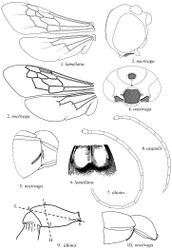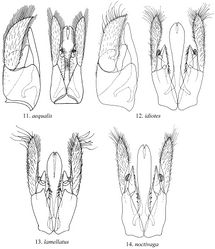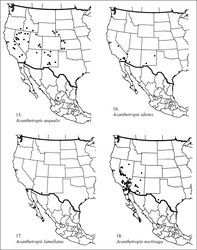Acanthetropis aequalis
| Notice: | This page is derived from the original publication listed below, whose author(s) should always be credited. Further contributors may edit and improve the content of this page and, consequently, need to be credited as well (see page history). Any assessment of factual correctness requires a careful review of the original article as well as of subsequent contributions.
If you are uncertain whether your planned contribution is correct or not, we suggest that you use the associated discussion page instead of editing the page directly. This page should be cited as follows (rationale):
Citation formats to copy and paste
BibTeX: @article{Kimsey2015JournalofHymenopteraResearch, RIS/ Endnote: TY - JOUR Wikipedia/ Citizendium: <ref name="Kimsey2015Journal of Hymenoptera Research">{{Citation See also the citation download page at the journal. |
Ordo: Hymenoptera
Familia: Tiphiidae
Genus: Acanthetropis
Name
Acanthetropis aequalis (Fox) – Wikispecies link – Pensoft Profile
- Brachycistis aequalis Fox 1899[1]: 284. Syntype males; Nevada (ANSP).
- Brachycistis normalis Malloch 1926[2]: 8. Holotype male; USA: South Dakota, Jackson Co., Cedar Pass (USNM). New synonymy.
Diagnosis
This species most closely resembles Acanthetropis idiotes. It can be distinguished by the shorter antennomeres, mesepisternum without vertical or transverse ridge, the shorter first metasomal segment and sharp median longitudinal ridge of metasomal sternum I.
Male description
Body length 6.5–13.0 mm. Head. Flagellum with appressed yellow pubescence; L/W ratio of flagellomere I 2.4–2.9 (Fig. 7); lower rim of antennal socket produced into distinct vertical carina beneath; clypeus with scattered punctures, becoming larger and irregular apically; gular carina elevated for most of length but not produced into an anterior tooth. Mesosoma. Pronotum with small punctures medially, larger, coarser laterally; mesepisternum with a low, rounded prominence anteriorly, not carinately produced, mesonotum with small, scattered punctures; propodeum with dorsum finely reticulate, impunctate, dorsal sulcus with edges scarcely or not appearing carinate, posterior transverse sulcus absent or poorly defined, without or with anterior ill-defined carina; posterior transverse carina often incomplete. Metasoma. Segment I short and stout, L/H 1.3–1.5 sternum with longitudinal sulcus expanded and deepened posteriorly, tergum heavily punctate; tergum II moderately to lightly punctate, punctures small and shallow; terga III-VII with punctures small, shallow except for row of larger, deeper punctures before apex; sternum II with median basal longitudinal ridge terminating in blunt spine (as in Fig. 6). Genital capsule (Fig. 11). Color. Uniform medium brown. Entire body clothed with long, golden setae.
Distribution
(Fig. 15). MEXICO: Baja California: Hamilton Ranch (4 km n Punta Gorda); Baja California Sur: 15 mi n El Rosario; Zacatecas: 10 mi n Fresnillo. USA: Arizona: Apache Co.: 14 km nnw Salina; Coconino Co.: Tuba City; California: Imperial Co.: Bard; Inyo Co.: Tinemaha Reservoir; Kern Co.: Randsburg; Mono Co.: Benton; Riverside Co.: Chino Canyon; San Bernardino Co.: Zzyzx Springs; Tulare Co.: White River; Idaho: Cassia Co.: 5 mi ne Malta; Elmore Co.: Glenns Ferry; Kansas: Cheyenne Co. (no locality given); Decator Co.: 5 mi e. Cedar Bluff; Morton Co. (no locality given); Seward Co. (no locality given); Stanton Co. (no locality given); Nebraska: Garden Co.: 8 mi ne Oshkosh: Sioux Co.: Agate; Nevada: Churchill Co.: Sand Mountain, 35 km se, 8 mi n Fallon; Blow Sand Mountains, San Mountain, 12 mi ne Stillwater; Elko Co.: Deeth; Esmeralda Co.: Clayton Valley dunes; Eureka Co.: 27.5 and 44 km w Carlin; Humboldt Co.: Golconda Summit, Winnemucca, 10 mi n Winnemucca; Nye Co.: Duckwater; Peavine Cyn.; Pershing Co.: Woolsey; Washoe Co., Fallon, south end Pyramid Lake, 3 mi n Nixon; White Pines Co.: 5 mi w Baker; New Mexico: Bernalillo Co.: Albuquerque; Chaves Co. (no locality given); Dona Ana Co.: Las Cruces; Otero Co.; Tularosa, 5 mi w Tularosa, White Sands; San Juan Co.: Chaco Cyn. Nat. Mon.; Taos Co.: Ojo Caliente; Torrance Co. (no locality given); Oregon: Malheur Co.: 12 mi s Blue Mt. Pass; South Dakota: Jackson Co., Cedar Pass; Utah: Emery Co.: Buckskin Springs, n. Goblin Valley; Grand Co.: Arches National Monument; San Juan Co.: Monticello; Weber Co.: Ogden; Wyoming: Converse Co.: Douglas; Platt Co.: Ft. Laramie; 723 males were examined including the holotype (BME, CAS, KSBS).
Seasonal distribution
This is a summer species, collected from June through September.
Discussion
When Malloch proposed Acanthetropis normalis as a new species in Brachycistis, he had only seen one specimen of Brachycistis aequalis Fox and thus was unaware of the amount of structural variation seen in that species. The differences he perceived in the dimensions of the first metasomal segment proved to fall within the normal range of variation of this trait in Acanthetropis aequalis.
Taxon Treatment
- Kimsey, L; Wasbauer, M; 2015: Revision of the odd brachycistidine genus Acanthetropis Wasbauer, 1958 (Hymenoptera, Tiphiidae, Brachycistidinae) Journal of Hymenoptera Research, (44): 19-30. doi
Images
|
Other References
- ↑ Fox W (1899) The North American Mutillidae. Transactions of the American Entomological Society 25: 219–300.
- ↑ Malloch J (1926) Systematic notes on and descriptions of North American wasps of the subfamily Brachycistidinae. Proceedings of the US National Museum 68: 1–28. doi: 10.5479/si.00963801.68-2604.1


